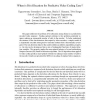Free Online Productivity Tools
i2Speak
i2Symbol
i2OCR
iTex2Img
iWeb2Print
iWeb2Shot
i2Type
iPdf2Split
iPdf2Merge
i2Bopomofo
i2Arabic
i2Style
i2Image
i2PDF
iLatex2Rtf
Sci2ools
92
Voted
DCC
2005
IEEE
2005
IEEE
When is Bit Allocation for Predictive Video Coding Easy?
This paper addresses the problem of bit allocation among frames in a predictively encoded video sequence. Finding optimal solutions to this problem potentially requires making an exponential number of calls to the encoder. To better understand the structure of the rate-distortion data output by video encoders, a simple model of a sequentially encoded autoregressive Gaussian random field is theoretically investigated. The rate-distortion data for the model exhibits an additive-separability property, i.e. the rate can be decomposed into a sum of independent functions of single distortion variables. This property implies the near-optimal behavior of a non-backtracking Steepest-Descent (SD) based bit allocation algorithm. The SD algorithm when applied to video coding produces near-optimal solutions by making a linear number of calls to the encoder. Results are presented for MPEG-2 encoding of standard video sequences.
Bit Allocation Algorithm | Computer Graphics | DCC 2005 | Produces Near-optimal Solutions | Rate-distortion Data Output |
Related Content
| Added | 25 Dec 2009 |
| Updated | 25 Dec 2009 |
| Type | Conference |
| Year | 2005 |
| Where | DCC |
| Authors | Yegnaswamy Sermadevi, Jun Chen, Sheila S. Hemami, Toby Berger |
Comments (0)

